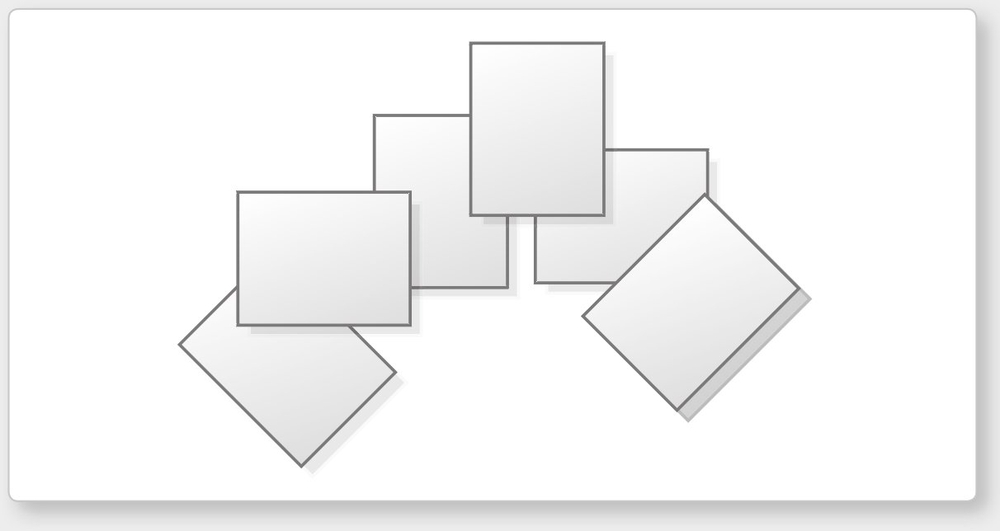We hear a lot these days about enhancing brain performance with mental exercises like crossword puzzles and the currently popular Sudoku. My own interest in puzzles stems from my ongoing effort to develop new and innovative approaches to brain-performance enhancement. Ive aimed at answering this question: What activities can my readers engage in that will enhance not just the whole brain but distinct brain areas and processes? In Mozarts Brain and the Fighter Pilot, I came up with a program based on twenty-eight suggestions. None of these involved puzzles. In my second brain-enhancement book, Think Smart: A Neuroscientists Prescription for Improving Your Brains Performance, I asked some of the worlds most prestigious brain scientists to tell me the specific activities they personally engage in to make their brains work better. During interviews and conversations with those neuroscientists, I was reminded of the importance of puzzles as brain enhancers and, as a result, included a small number of puzzles in Think Smart. At that point I began to look a bit deeper.
Over the years I had always been fascinated with puzzles. They are a fun way to stimulate the brain. But can they actually improve different brain functions, such as memory, reasoning, and three-dimensional visualization, among others? Over the course of writing nineteen books on the brain, I encountered a lot of formal and informal research suggesting the answer to that question is yes. Gradually I became convinced that puzzles can help enhance specific brain functions and, as studies suggest, actually help ward off mental deterioration.
What I needed, I reasoned, was a brain-puzzle book that included puzzles of every sort accompanied by an explanation of the brain benefits that can be expected from the different ones. As far as I could determine, no such book was available. Sure, any number of brainteaser books existed that contained puzzles purported to challenge the brain. But none of them discussed what happened in the brain while solving the puzzles or provided any explanation of how different puzzles challenged specific brain areas. Nor did they suggest what kind of puzzle to select in order to improve specific brain functions. Although I saw the need for such a book and was enthusiastic about writing it, one huge impediment stood in my way: my strictly amateur status as a puzzle solver (forget altogether about my not being a puzzle designer). Since I could go only so far as an amateur puzzle aficionado, I needed to be in touch with a professional: a puzzle master.
Anyone with an interest in puzzles soon comes into contact with my favorite puzzle master, Scott Kim. For years Ive been fascinated and intrigued with Scotts puzzle-creating genius. One afternoon, while working on a series of his puzzles I came up with the idea of an innovative performance-enhancement book based on puzzles. The book would combine my knowledge about the brain with Scotts puzzle-creating talents in order to help our readers increase their brain power via entertaining and instructive puzzle challenges. Scott, as I later learned, had been thinking along similar lines while writing his regular puzzle column for Discover magazine and maintaining his website, www.scottkim.com.
In 2006 my curiosity about the brainpuzzle connection led me to contact Scott. To my delight I discovered that he was familiar with my work as well as the research findings and published writings of many other neuroscientists. Most important, he was well aware that puzzles can be used as brain enhancers. After speaking to each other for several hours while attending a neuroscience meeting, we both came away convinced that by working in collaboration we could create a unique pathway to enhancing brain function through puzzles. That meeting was the genesis of this book.
When we finally got together to plan the book, we talked about how we could combine information about the brain with the fun and challenge of solving puzzles. Heres the plan we came up with: First, I would identify and write about those brain functions that inevitably undergo decline unless deliberate efforts are taken to enhance them. Included here are concentration, memory, fine motor skills, visual observation, logic, numbers, vocabulary, visual-spatial thinking, imagination, and creativity. Then Scott would develop puzzles aimed at engaging and challenging each of these mental functions. Like two jazz musicians working out a contrapuntal melody, we would take up each mental function. I would write about what we know of the relevant brain processing, and Scott would design puzzles aimed at engaging and challenging the brain areas responsible for that function. Obviously we couldnt cover everything about the brain, so we concentrated on areas that lent themselves most easily to puzzles. The chapters would be self-contained and, because they featured puzzles, fun to read in any sequence according to the interests of the readersort of like leisurely making a selection from a box of delicious candy.
Following are three examples, drawn from Scotts vast puzzle output, of the kinds of things well be covering in this book.
LETTER SWAP(Word Thinking)
ANSWER ON PAGE 11
 This puzzle exercises your ability to recall words based on meaning and spelling.
This puzzle exercises your ability to recall words based on meaning and spelling.
L ook at the string of boxes in the diagram and place letters in the boxes to spell two words differing by only one letter, like CHANGE and CHANCE. The final letter H in one word will become a P in the other word.
Readers who deal primarily with words rather than images or abstract concepts will more easily solve this puzzle, which challenges the left, language-mediating hemisphere of the brain. Since Scott has identified this as a hard puzzle, perhaps I should give you a hint: Hold hands or fight. If you still havent gotten it, heres another hint: The first letter is C. The solution is on page 11.
In chapter 9, on words and language, Ill use puzzles like this, combined with some of the newest positron emission tomography (PET) and functional magnetic resonance imaging (fMRI) findings, to explain how the brain is organized for language, the importance of lifetime vocabulary building, and how to use language to think creatively. Each of the points will be illustrated by puzzles and exercises such as the one you just solved.
As an immediate follow-up to that word puzzle, lets try a puzzle that challenges a completely different part of the brain. Tests of spatial thinking are especially brain-performance-enhancing for those of us who arent architects or designers because they force us to use parts of our brain that we dont usually call upon. Here is one of Scotts puzzles that can be solved only visually-spatially:
PAPERWORK(Spatial Thinking)
ANSWER ON PAGE 11
 This puzzle exercises your ability to arrange items in space according to rules.
This puzzle exercises your ability to arrange items in space according to rules.
L ay six sheets of paper flat on a table so that each sheet overlaps above exactly one other sheet, and overlaps below exactly one other sheet. The sheets may not be folded, cut, or bent.
No amount of verbal reasoning can lead to the solution to that puzzle. The correct answer can come only from mentally moving the sheets in ones mind. Hint: Picture the papers joining together to form a simple geometric form.

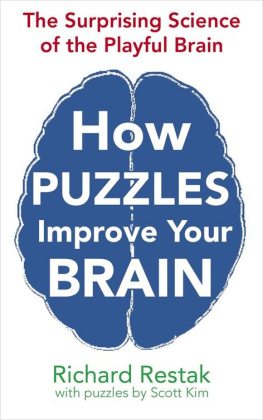
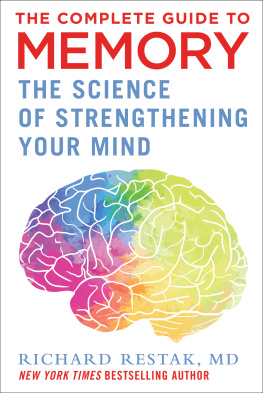
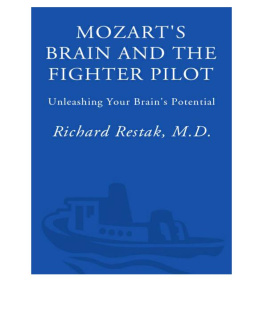

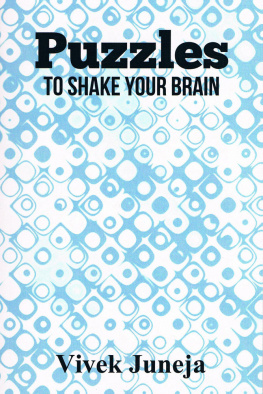
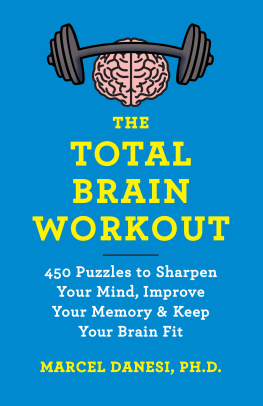
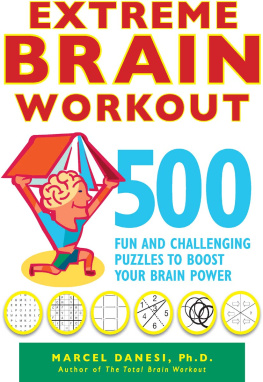
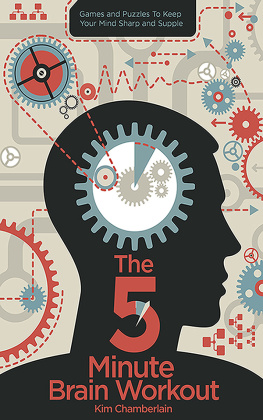
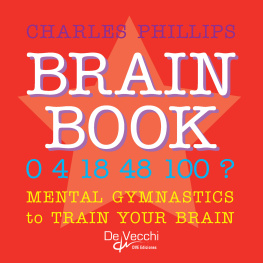
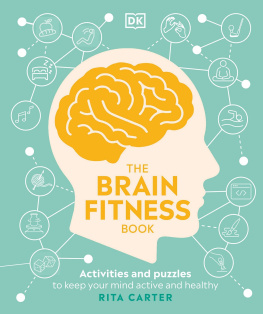
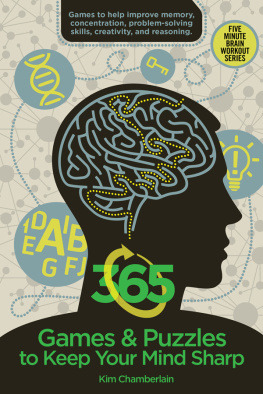
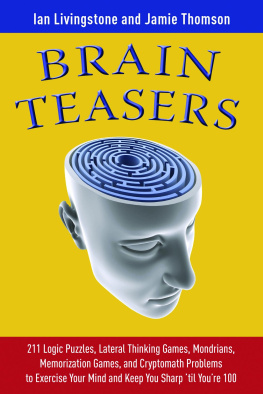
 This puzzle exercises your ability to recall words based on meaning and spelling.
This puzzle exercises your ability to recall words based on meaning and spelling.
